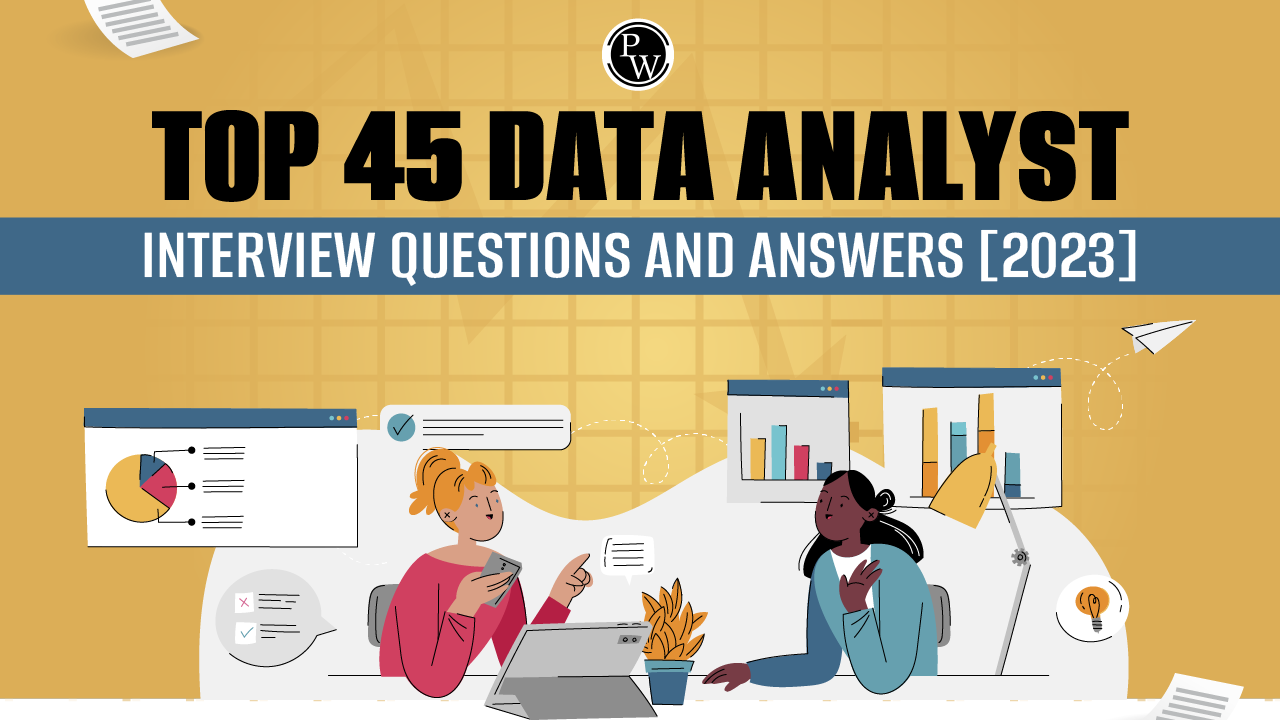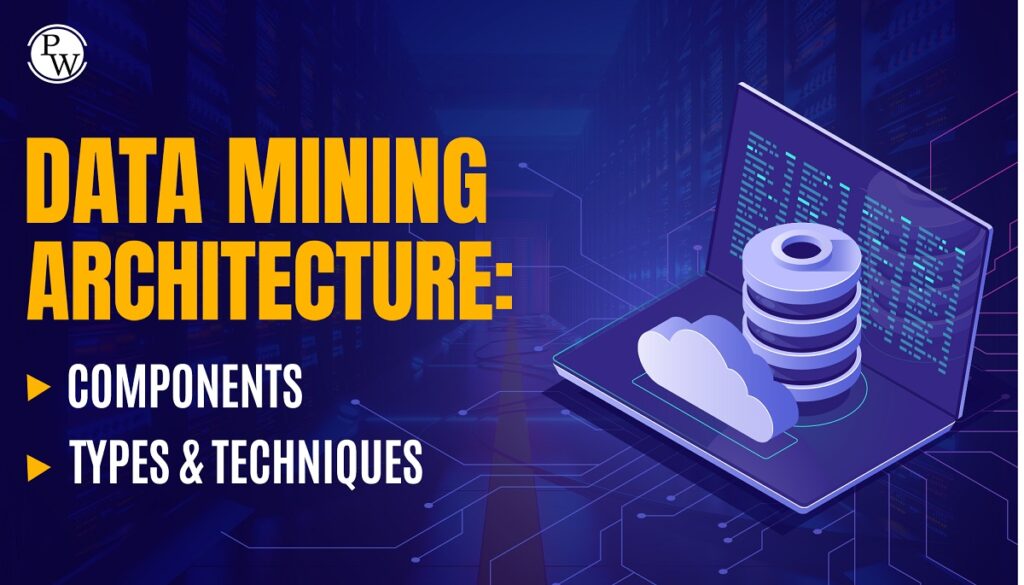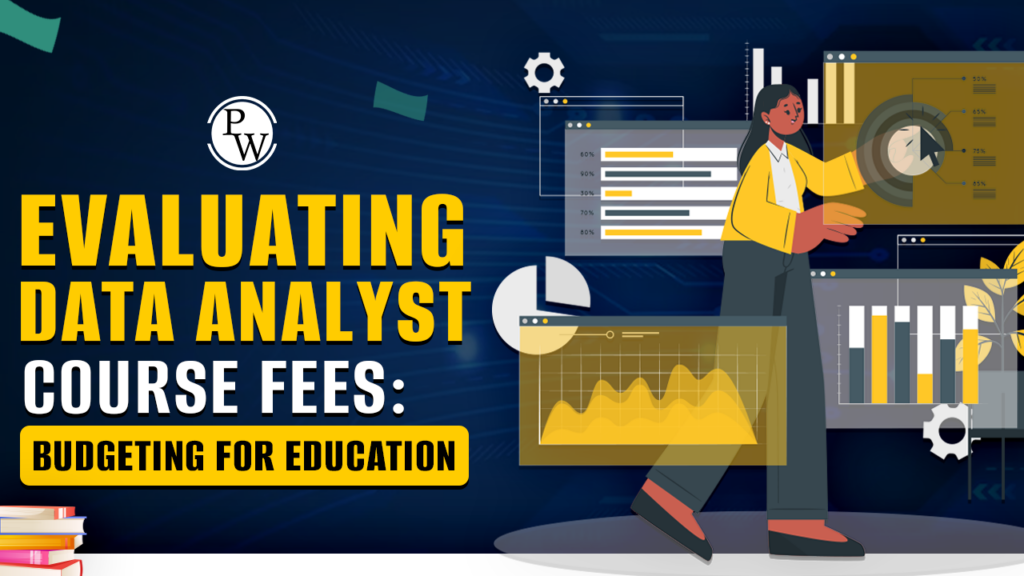Data Analyst Interview Questions: In the dynamic world of data analysis, where every dataset conceals hidden insights and potential, job interviews are the gateways to an exciting career. As we step into 2023, the landscape of data analysis continues to evolve, with new tools, techniques, and challenges emerging. To set out on a successful career into this data-driven realm, you need to be thoroughly-prepared.
You need to be prepared to answer the questions that interviewers will ask and also convince them of your problem-solving skills, adaptability, and communication prowess. If you want to improve your chances of succeeding as a data analyst, a Full-Stack Data Analytics course is highly recommended. In this blog, we’ve gathered the 45+ Data Analyst Interview Questions with Answers for 2023.
45+ Data Analyst Interview Questions and Answers That Interviewers Ask in 2023
Here are the best data analyst interview questions with answers in 2023:
1. Can you explain what a data analyst does?
A data analyst’s main job is gathering, processing, and evaluating data. They employ tools and methods to uncover valuable insights in data, assisting organisations in making informed choices. This involves cleaning data, conducting statistical analyses, creating data visualisations, and producing reports to back data-focused decision-making.
2. What is data cleaning, and why is it important in data analysis?
Data cleaning entails identifying and correcting errors or inconsistencies in datasets. It is vital because inaccurate or incomplete data can result in incorrect conclusions and poor decision-making. The cleaning process involves addressing missing data, eliminating duplicates, and rectifying outliers.
3. Explain the differences between structured and unstructured data.
Structured data, found in databases, is easy to analyse with tables and rows. Unstructured data, like text or multimedia, lacks a set structure, requiring special analysis techniques due to its non-tabular nature.
4. What is data normalisation, and why is it used?
Data normalisation organises data to reduce redundancy and maintain integrity. It standardised data to eliminate inconsistencies, ensuring high quality and preventing issues in databases.
5. Can you describe the steps involved in the data analysis process?
Data analysis involves multiple stages: collection, cleaning for quality, exploration for understanding, modelling using statistical or machine learning methods, visualisation for meaningful insights, and reporting to convey findings to stakeholders.
6. How do you deal with missing data in a dataset?
Handling missing data is essential for accurate analysis. Two common methods are imputation, where missing values get estimated from available data, and exclusion, which involves removing incomplete records. The choice depends on the dataset’s characteristics and the impact of missing data on the analysis.
7. Explain what data visualisation is and its importance.
Data visualisation simplifies complex information through graphical representation. It enhances data analysis by quickly revealing patterns, trends, and outliers. Effective visualisations convey insights to non-technical audiences and support decision-making.
8. What are the differences between a histogram and a bar chart?
Histograms depict the distribution of continuous data, showing the frequency of data points within specific intervals. In contrast, bar charts represent categorical data with separate bars for distinct categories. While histograms have continuous bars, bar charts display non-continuous, distinct bars.
9. How would you determine the outliers in a dataset?
Detecting outliers involves using statistical techniques like the z-score and Interquartile Range (IQR). These methods pinpoint data points significantly deviating from the norm, which can distort statistical analysis. Thus, recognizing and appropriately managing them is vital.
10. What is the purpose of a pivot table in data analysis?
A pivot table serves as a data summarization tool, commonly employed in spreadsheet software. Users can rearrange and consolidate data to produce customised tabular reports. Pivot tables aid in extracting meaningful insights and patterns from extensive datasets, making them an invaluable resource for data analysis.
Also Read: Top 25 Big Data Interview Questions and Answers
11. What are the main components of a time series analysis?
Time series analysis encompasses several elements. Trend represents the data’s long-term direction, seasonality highlights recurring patterns, and noise accounts for random fluctuations. Grasping these components is essential for precise predictions and identifying historical patterns in time-based data.
12. Explain the concept of correlation.
Correlation quantifies the statistical relationship between two variables. It gauges how changes in one variable correspond to changes in another. Correlation coefficients, like Pearson’s r, indicate the strength and direction of the relationship, which may be positive (both variables increase), negative (one increases as the other decreases), or negligible.
13. How do you assess the quality of a machine learning model?
Machine learning model assessment relies on various metrics. These metrics, such as accuracy, precision, recall, F1 score, and ROC AUC, differ depending on the specific problem and objectives. They gauge a model’s performance in classification and regression tasks.
14. What is the difference between supervised and unsupervised learning?
Supervised learning utilises labelled data for training. Its purpose is to predict or classify data based on known outcomes. Unsupervised learning, on the other hand, deals with unlabeled data and concentrates on revealing patterns, structures, or groupings within the data without predefined categories.
15. Can you explain what the K-means clustering algorithm is?
K-means, an unsupervised algorithm, clusters data points into groups. It achieves this by minimising the sum of squared distances between data points and their assigned cluster centres. The number of clusters, represented as “k,” is a vital parameter decided before using the algorithm.
16. How do you handle a situation where your model overfits the data?
To counter overfitting, strategies like cross-validation ensure generalisation. Other methods involve using a simpler model, reducing features, and employing regularisation techniques like L1 or L2. Proper hyperparameter tuning is crucial to balance model complexity and performance.
17. What is the purpose of cross-validation in machine learning?
Cross-validation evaluates machine learning model performance by repeatedly dividing the dataset for training and testing. This prevents the model from learning data noise, ensuring reliable performance assessment.
18. Can you explain the concept of A/B testing?
A/B testing compares two versions of a webpage, app, or product feature to determine the better performer. Users are randomly assigned to groups A and B, and their responses to design, content, or functionality variations are measured. This optimises user experiences and enhances marketing and product development results.
19. How would you approach data analysis for a project with incomplete or unclear requirements?
To start, I would conduct stakeholder interviews for gathering information and clarifying requirements. Exploratory data analysis (EDA) would uncover potential data patterns and insights, refining the analysis approach as the project progresses.
20. Describe a time when you had to work with a large dataset. What challenges did you face?
I worked on a project with a massive dataset. It had millions of records. Challenges included managing data storage, dealing with long processing times, and developing efficient algorithms for the vast data.
21. How do you stay updated with the latest developments in data analysis and analytics tools?
I also used data sampling and parallel processing to boost efficiency. To stay updated, I read industry blogs and journals, joined online data science communities, and attended webinars and conferences. I also worked on personal projects to experiment with new tools, techniques, and datasets. This ensured continuous learning and improvement.
22. What do you consider the most significant data analysis project you’ve completed, and what was the outcome?
One impactful project involved analysing customer purchase history and product sales for a retail company. By finding buying patterns and suggesting product bundles, we increased sales by 20%. This showed the practical business value of data analysis.
23. How would you explain complex technical concepts to a non-technical audience?
In explaining complex ideas, I use simple comparisons and avoid technical terms. Visual aids, like graphs and real-world examples, can make information easier for non-experts to understand.
24. What do you believe is the most exciting trend in data analysis for 2023?
In 2023, the blend of artificial intelligence and machine learning in data analysis is an exciting trend. These technologies offer advanced insights, predictive abilities, and automation, making data analysis more potent and efficient.
25. Can you explain the difference between data mining and data analysis?
Data mining aims to uncover hidden patterns and trends in data, often without much prior knowledge. Meanwhile, data analysis involves exploring data to gain insights, create reports, and make informed decisions.
26. How do you handle conflicting priorities when working on multiple data analysis projects simultaneously?
To handle conflicting priorities, set clear goals, make task lists, and prioritise projects based on importance and deadlines. Effective communication with stakeholders is crucial for managing expectations, ensuring transparency, and balancing workloads.
27. Explain the importance of data security in data analysis.
Data security stands as a top priority to safeguard sensitive information and maintain trust with stakeholders. Data breaches may result in legal and reputational consequences, highlighting the importance of secure storage, access control, and encryption in data analysis procedures.
28. Can you describe a time when your analysis revealed unexpected insights that had a significant impact on a project?
During a market analysis project, I uncovered an unforeseen surge in demand for a specific product category in a particular season. This discovery enabled us to adapt marketing strategies, leading to a 30% sales increase during that period, demonstrating the significance of data analysis.
29. What are the key metrics for measuring the performance of a data analytics team?
Crucial metrics for assessing the performance of a data analytics team encompass project completion time, accuracy of insights, stakeholder satisfaction, and the team’s capability to fulfil business objectives. These metrics aid in evaluating the team’s efficiency, effectiveness, and overall impact on the organisation.
30. Explain the concept of data-driven decision-making.
Data-driven decision-making means using data and analysis to guide choices, leading to more precise and efficient decision-making. It underscores the importance of relying on data insights and trends, supported by evidence, to drive well-informed, impartial, and outcome-focused decisions.
31. Can you discuss the potential ethical concerns in data analysis?
Ethical issues in data analysis may encompass concerns regarding data privacy, algorithmic bias, and responsible data usage. Data analysts must ensure that their analyses do not harm individuals or groups, safeguard privacy, and mitigate bias to foster fair and ethical data practices.
32. How do you handle situations where your analysis results in unfavourable news or conclusions?
When confronted with unfavourable results, I transparently convey findings, emphasising actionable insights and proposing potential solutions or remedies. It’s crucial to present challenges while highlighting opportunities for enhancement, displaying a proactive and constructive approach.
33. Describe a project where you used data analysis to identify cost-saving opportunities.
In a manufacturing project, I analysed production processes and equipment maintenance records. By optimising machine maintenance schedules using historical data, we decreased downtime and maintenance expenses by 15%, resulting in substantial cost savings.
34. How do you assess the impact of outliers on data analysis results?
I assess outliers’ impact by comparing analysis outcomes with and without them, helping decide if they greatly affect conclusions or have a minor role, guiding informed outlier handling.
35. Can you discuss the challenges of working with real-time data in data analysis?
Real-time data analysis brings challenges like efficient data pipelines, managing data velocity, and ensuring data precision at high speeds. It demands swift data processing and storage for continuous real-time data inflow.
36. How do you ensure data quality and accuracy in your analysis?
To uphold data quality and precision, I enforce data validation checks, confirm data sources, and use data cleansing methods like eliminating duplicates and rectifying errors. Consistently updating and reviewing data, along with robust data governance practices, is vital for data reliability.
37. Can you explain the importance of data storytelling in data analysis?
Data storytelling means presenting data insights in a narrative style for clarity and engagement. It’s vital for conveying intricate findings to non-technical stakeholders, aiding understanding, and improving decision-making by making data insights relatable and memorable.
38. What is the difference between a data analyst and a data scientist?
Data analysts concentrate on interpreting and reporting data to offer insights and aid decision-making. They mainly work with organised data and use statistical and data manipulation methods. In contrast, data scientists perform advanced tasks, including data modelling, machine learning, and algorithm development, often with unstructured or big data.
39. How do you handle confidential or sensitive data in your role as a data analyst?
I rigorously follow data protection and confidentiality rules for sensitive information. This means limiting access to authorised personnel, using secure methods for storing and transmitting data, and encrypting and anonymizing sensitive data when necessary.
40. Can you describe the steps involved in creating a data analysis report?
Creating a data analysis report involves multiple steps. These steps include defining the report’s purpose and objectives, collecting and cleaning data, exploring and analysing the data, creating visualisations, drawing meaningful conclusions, and composing a clear, concise narrative to effectively convey insights to stakeholders.
41. Explain the concept of data lineage in data analysis.
Data lineage traces the data’s journey from its source through various transformations and processing stages to its final destination. It aids in monitoring data quality, compliance, and lineage metadata, ensuring data integrity, and promoting transparency in data analysis processes.
42. How do you choose the appropriate data visualisation for a specific dataset?
Selecting the proper data visualisation relies on the data’s characteristics and your communication objectives. For instance, you may employ bar charts for category comparisons, line graphs to illustrate time-based trends, scatter plots for showcasing relationships, and heatmaps for highlighting intricate patterns within dense data.
43. What are the advantages and disadvantages of using open-source data analysis tools?
Open-source software such as Python and R offers a cost-effective solution with a thriving user community. Nonetheless, they may lack formal support and comprehensive documentation. Evaluating their benefits in comparison to potential drawbacks is pivotal when choosing tools for particular projects.
44. Can you explain the concept of data governance in data analysis?
Data governance encompasses the establishment and execution of guidelines and procedures to oversee data throughout its entire existence. It guarantees the quality, consistency, and security of data. Sound data governance is fundamental for upholding transparency, conformity, and the trustworthiness of data analysis.
45. How do you handle data from multiple sources with different formats in an analysis project?
When handling diverse data sources, you employ data integration tools or custom scripts for transforming and standardising data, making it consistent for analysis, ensuring data’s compatibility and reliability.
46. Describe a project where you used data analysis to improve customer satisfaction.
In a project focused on analysing customer feedback, I systematically pinpointed recurring issues in negative feedback. Recommendations for enhancing products and customer service were put into action, leading to a substantial 25% surge in customer satisfaction, confirming the effectiveness of data-driven changes.
47. Can you discuss the concept of exploratory data analysis (EDA) and its role in data analysis?
Exploratory Data Analysis (EDA) stands as a crucial initial step in comprehending data. It entails summarising data attributes, creating visual representations, and spotting patterns and anomalies. EDA establishes the groundwork for deeper analysis, enabling analysts to grasp the intricacies of a dataset.
48. How do you manage and prioritise your work as a data analyst to meet deadlines and expectations?
Efficient time management is vital. I utilise project management tools, construct task lists, and prioritise tasks according to project objectives and deadlines. Maintaining consistent communication with stakeholders guarantees alignment, aids in managing expectations, and allows for flexible adjustments when necessary.
Also Check: How to Become a Data Analyst in 2023?
Conclusion
In the dynamic world of data analysis, the ability to navigate through complex questions and unravel data’s hidden insights is a remarkable skill. As we’ve looked at the best data analyst interview questions and answers for 2023, remember that success in this field isn’t just about knowing the right responses; it’s about embracing creativity, adaptability, and effective communication.
Each interview question is an opportunity to showcase your problem-solving prowess. So, step into that interview room with confidence, leverage your knowledge, and paint a vivid picture of your capabilities. May your path be marked by data-driven success and a fulfilling career ahead.
Want to learn how to make sense of big data? PhysicsWallah’s Full Stack Data Analytics Course can teach you how. Our course covers all aspects of data analytics, from data collection and cleaning to data visualisation and machine learning. Enrol now and start your journey to becoming a sought-after data analyst!
FAQs
Can you elaborate on the impact of data analysis in healthcare?
Data analysis in healthcare enhances patient care, diagnoses, and resource allocation, leading to better outcomes, reduced costs, and improved public health.
How do you manage the ethical implications of data analysis, especially with sensitive data?
Ethical considerations involve respecting data privacy, mitigating biases, and ensuring transparency. A clear code of ethics guides data analysts in making ethical decisions.
What is the significance of data governance frameworks in data analysis projects?
Data governance frameworks ensure consistency, quality, and compliance throughout data analysis projects, facilitating better decision-making and reducing risks.
How do you ensure that data analysis remains relevant as businesses evolve?
Regularly reassessing data analysis goals, tools, and methodologies allows businesses to adapt and remain relevant in the face of evolving needs and objectives.
What's the role of data analysis in market segmentation and targeting?
Data analysis helps identify customer segments with shared characteristics, enabling businesses to tailor their marketing efforts more effectively and increase ROI.
Can you describe the impact of data analysis on supply chain optimization?
Data analysis optimises supply chains by improving demand forecasting, inventory management, and logistics, leading to cost savings and better customer service.
How do you handle the integration of real-time data streams in data analysis?
Managing real-time data requires robust data pipelines, efficient processing, and automated alert systems to ensure timely insights and actions.
How do data analysts deal with data from unstructured sources like social media?
Data analysts use natural language processing and sentiment analysis to extract valuable insights from unstructured data, helping businesses understand customer sentiment and market trends.
What are the critical considerations for choosing a data visualisation tool?
Selecting the right tool involves considering factors like data complexity, the audience, interactivity, and the storytelling capabilities required for effective data communication.
How does data analysis contribute to disaster response and management?
Data analysis aids disaster management by assessing situational data, coordinating resources, and predicting potential impacts, helping to mitigate and respond to crises effectively.





